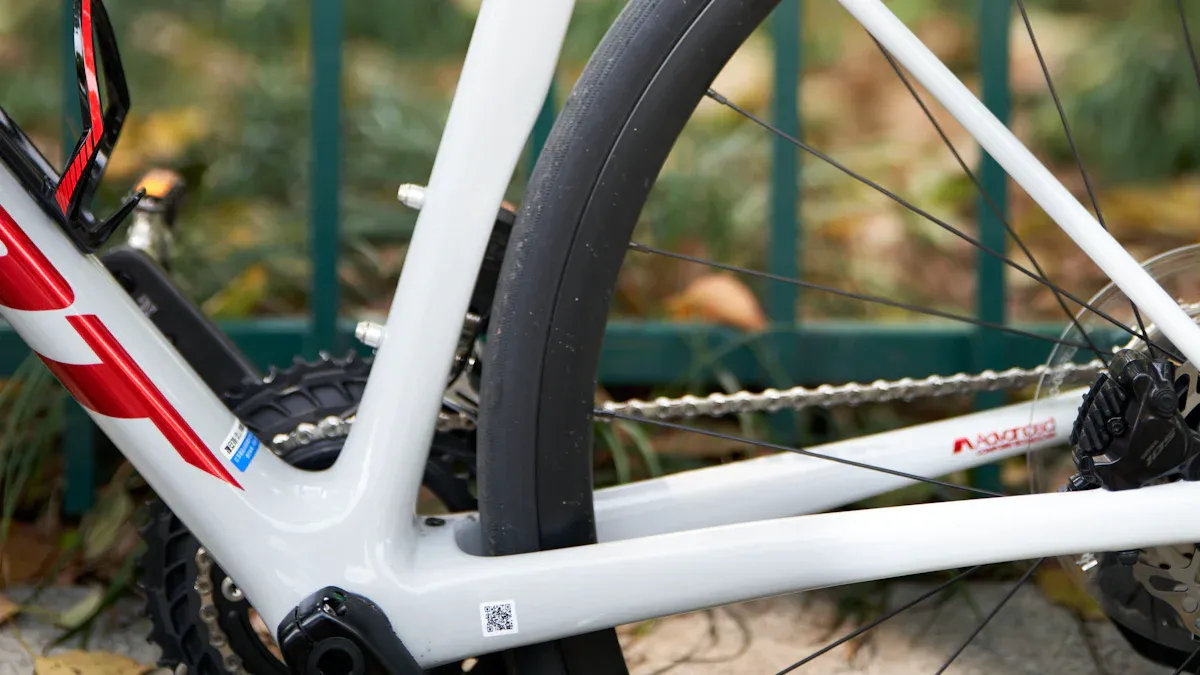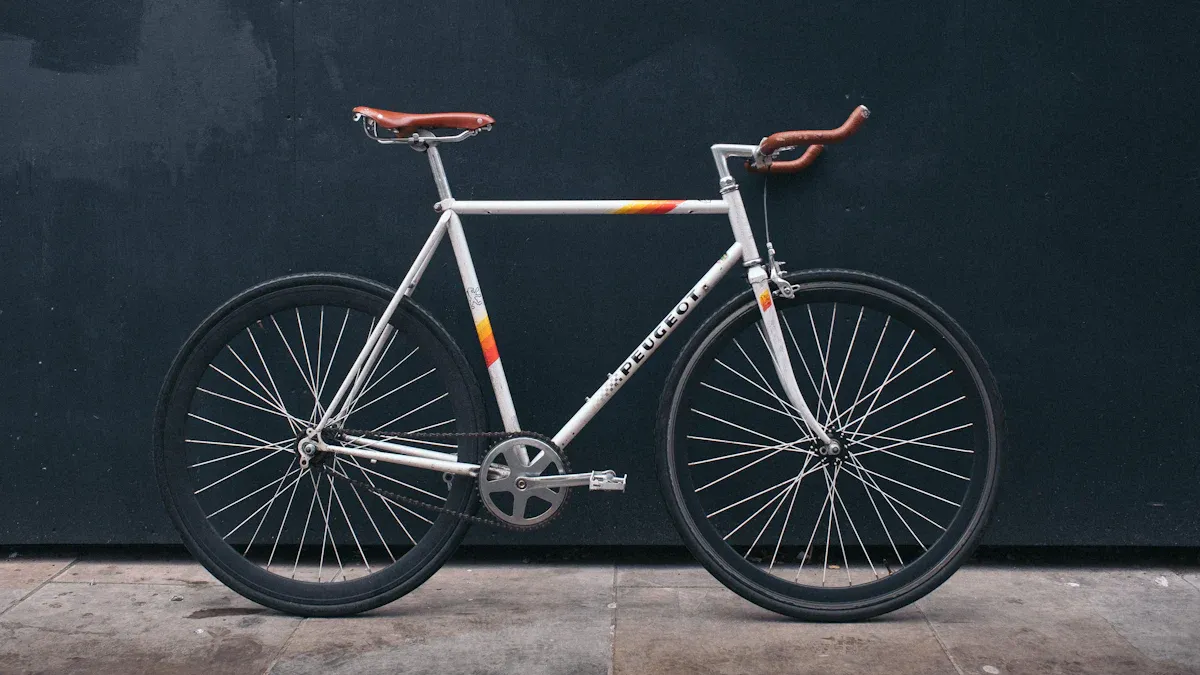
Choosing the right road bike frame is very important, especially when considering the road bike frame differences. It affects how well you ride and how comfortable you feel. Different materials and shapes can change how the bike responds, stays stable, and is easy to handle. For example, research shows that a steeper seat tube angle can improve speed and efficiency. So, what are the main road bike frame differences? Knowing these differences can help you make a smart choice.
Key Takeaways
Picking the right road bike frame is important. It affects how comfortable you feel and how well you perform. Think about your riding style and needs before you decide.
Carbon frames are light and perform very well. They are good for going fast, but they can be stiff. It is also harder to see if they are damaged.
Steel frames are strong and comfortable. They are heavier, but they can absorb bumps well. This makes them great for long rides.
Aluminum frames are a good mix of weight and cost. They are strong and not too expensive, but they might feel less comfy on rough roads.
Titanium frames are both strong and light. They give a smooth ride and do not rust, but they cost more money.
Carbon Frame Differences

Characteristics of Carbon Frames
Carbon bike frames have special features that make them different from other materials. Here are some key traits:
Lightweight: Carbon frames usually weigh 600 to 1100 grams. This is much lighter than steel (2000-2500 grams) and aluminum (1100-1500 grams) frames.
High Stiffness: Carbon has a high stiffness-to-weight ratio. This means you get better performance with less energy loss when riding.
Customization: Makers can shape carbon in many ways. This allows for designs that improve aerodynamics.
Fatigue Resistance: Carbon is very resistant to fatigue. This means it lasts a long time.
Corrosion Resistance: Unlike steel, which can rust, carbon does not corrode easily.
Characteristic | Carbon Fiber | Steel/Aluminum/Titanium |
|---|---|---|
Weight | Lightweight | Heavier |
Stiffness | High | Varies |
Customization | Highly customizable | Limited |
Fatigue Resistance | High | Varies |
Corrosion Resistance | Excellent | Poor (for steel) |
Aerodynamics | Superior | Inferior |
Advantages of Carbon Frames
Choosing a carbon frame can give you many benefits for cycling:
Performance: The light weight of carbon frames improves bike performance. You can speed up faster and climb hills easier.
Vibration Damping: Carbon absorbs vibrations well. This gives you a smoother ride, especially on bumpy roads.
Aerodynamics: Custom shapes help with aerodynamics. This reduces drag and makes you go faster.
Durability: If you take care of them, carbon frames can last several years. They usually last about 4 to 8 years, depending on how much you use them.
Disadvantages of Carbon Frames
Even though carbon frames have many good points, they also have some downsides:
Rigidity: Some riders think carbon frames are too stiff. This can make long rides uncomfortable.
Risk of Failure: There is a chance of sudden failure. Some frames have been known to break unexpectedly, which can be scary.
Damage Detection: Finding damage can be hard. Cracks and defects are often harder to see than on metal frames.
Brittleness: Carbon is more brittle than aluminum and steel. This increases the chance of sudden breaks.
Steel Frame Overview

Steel bike frames are popular with cyclists because of their special qualities. Knowing their features can help you decide if they fit your riding style.
Characteristics of Steel Frames
Steel frames have several important traits:
Durability: Steel is very strong. It works well in different riding conditions.
Flexibility: Steel can bend a little. This helps it absorb shocks and vibrations, making rides more comfortable.
Weldability: You can fix and change steel frames easily. This makes them appealing to many.
Weight: Steel frames are heavier than carbon and aluminum. But they feel sturdy. Here’s how they compare in weight:
Material | |
|---|---|
Carbon | 10 |
Aluminum | 8 |
Titanium | 8 |
Steel | 6 |
Advantages of Steel Frames
Choosing a steel frame has many benefits:
Comfort: Steel has a springy feel. This helps reduce bumps on rough roads. It’s great for long rides.
Longevity: Steel frames can handle a lot of stress and rough paths. They last a long time.
Repairability: If they get damaged, you can fix steel frames easily. Other materials might need a full replacement.
Cost-Effectiveness: Steel frames are cheaper than carbon fiber and titanium. This makes them affordable for many cyclists.
Disadvantages of Steel Frames
Even with their good points, steel frames have some downsides:
Weight: Steel frames are heavier than aluminum and carbon. This extra weight can slow you down and make it harder to steer.
Rust: Steel can rust and corrode, especially in wet areas. You need to take care of them to avoid this.
Cost: While they are usually cheap, high-quality steel frames can still cost more than aluminum ones.
Aluminum Frame Insights
Aluminum bike frames are liked by many cyclists for good reasons. Knowing their features can help you see if they match your riding style.
Characteristics of Aluminum Frames
Aluminum frames have special traits that make them different:
Lightweight: Aluminum is lighter than steel. This helps with handling and climbing.
High Strength-to-Weight Ratio: This means they are strong but still light.
Corrosion Resistance: Aluminum does not rust easily. It works well in different weather.
Malleability: This lets makers create many shapes and designs.
Excellent Stiffness: You will have responsive rides and good power transfer.
Most aluminum bike frames use the 6061 aluminum alloy. This alloy is great for welding and is very strong. It has a tensile strength of over 260 MPa and a yield strength of more than 240 MPa in its T6 state.
Advantages of Aluminum Frames
Choosing an aluminum frame has many good points:
Durability: Aluminum frames can take a lot of hits. They are great for beginner cyclists.
Weight Efficiency: The strong but light design helps performance.
Cost-Effectiveness: Aluminum frames usually cost less than carbon fiber. This lets you buy other gear.
Fatigue Resistance: Aluminum frames last longer than steel frames when used a lot.
Disadvantages of Aluminum Frames
Even with their good points, aluminum frames have some downsides:
Stiffness: Bigger tubes make them stiffer. This can make rides less comfy.
Harsher Ride: Many riders feel aluminum frames are not as comfy. They have less flex and do not absorb bumps well.
Dynamic Load Failure: In some cases, aluminum can break. This shows how important design is in making frames.
Titanium Bike Frames
Characteristics of Titanium Frames
Titanium bike frames are special because of their unique features. Here are some important traits:
Characteristic | Description |
|---|---|
They are lightweight but still very strong. | |
Corrosion Resistance | They last a long time in different weather. |
Natural Damping Properties | They absorb bumps from the road for a smoother ride. |
Longevity | These frames do not get weak over time. |
Biocompatibility | They are safe and non-toxic for riders. |
Titanium combines the strength of steel with the lightness of aluminum. This makes it a great choice for bike frames. Modern titanium gravel bikes can weigh about the same as aluminum frames, making them competitive in weight.
Advantages of Titanium Frames
Choosing titanium bike frames has many benefits:
Exceptional Durability: Titanium frames can last a very long time. They resist cracking and fatigue better than aluminum and carbon fiber.
Corrosion Resistance: You don’t have to worry about rust. Titanium can handle different weather, making it great for touring and gravel riding.
Comfortable Ride: The natural flex of titanium helps absorb shocks. This means less tiredness and a more enjoyable ride, especially on long trips.
Consistent Performance: Well-made titanium frames keep their strength and ride quality over time. You can have a smooth ride even on rough paths.
Disadvantages of Titanium Frames
Even with their many good points, titanium bike frames have some downsides:
Higher Cost: Titanium frames start at about $1,899 for good quality. Custom builders can charge much more.
Weld Sensitivity: The way titanium is made makes welds more likely to crack. This can lead to more failures compared to other materials.
Limited Aerodynamic Design: Shaping titanium into aerodynamic forms can be hard. This might limit some modern design features.
Road Bike Frame Differences by Type
Performance vs. Endurance Frames
When picking a road bike, it’s important to know the differences between performance and endurance frames. Each type has a different purpose and changes how you ride.
Performance frames are all about speed and quickness. They have a more aggressive shape. This lets you ride lower and more aerodynamically. This design helps you move faster through the wind. Here’s a quick look at the two frame types:
Feature | Road Bike Performance Frames | Endurance Frames |
|---|---|---|
Geometry | More extreme, aerodynamic position | More upright, stable shape |
Riding Position | Lower and more forward, aggressive stance | Upright, comfy for long rides |
Handling | Quick handling, fast response | Steady control, less quickness |
Intended Use | Racing, speed-focused | Long rides, comfort-focused |
On the other hand, endurance frames focus on comfort for long rides. They have a more relaxed shape, which lets you sit up straight. This design helps reduce strain on your back and neck during long rides. It’s great for cyclists who like to go on longer trips.
Gravel and Touring Bikes
Gravel bikes and touring bikes are made for different adventures. Both types have special features that make them different from regular road bikes.
Gravel bikes are made for many types of terrain. They can handle rough paths and unpaved roads. Their shape is more upright, giving you stability and comfort. Here’s how they compare to touring and road bikes:
Feature | Touring Bike Design | Road Bike Design | |
|---|---|---|---|
Chainstays | Longer (420-435 mm) for stability | Long (430 mm or longer) for stability | Shorter for quicker handling |
Wheelbase | Longer than road bikes for stability | Longer for stability | Shorter for agility |
Head Tube Angle | 70-72 degrees for stability | Slacker for stability | 74 degrees for aerodynamics |
Head Tube Length | Longer for an upright position | Longer for comfort | Shortest for aerodynamic position |
Bottom Bracket Height | Lower (260-280 mm) for stability | Lower for stability | Higher for clearance |
Tire Clearance | Plenty for 40mm or bigger tires | N/A | N/A |
Frame Material | Carbon, aluminum, steel, titanium | N/A | N/A |
Touring bikes, on the other hand, are made for long trips. They focus on comfort and stability, allowing you to carry gear for long journeys. The shape of touring bikes supports a more relaxed riding position, making them great for long hours on the road.
Other Frame Types
Besides performance and endurance bikes, you might see other frame types for specific cycling needs. For example, aero bikes are made for speed. They have smooth shapes that cut down drag. Time trial bikes are similar but focus even more on aerodynamics, making them perfect for racing.
You may also find sportive bikes. These bikes mix features from both performance and endurance frames. They offer a good balance of speed and comfort, making them great for different riding styles.
Selecting a Frame
Choosing the right road bike frame is important. You should think about your budget, riding style, and personal likes. Each of these things helps you pick a frame that fits your needs.
Budget Considerations
Setting a budget is very important. Decide how much money you can spend on a frame. High-end carbon fiber frames usually cost more. Aluminum frames are cheaper but still good quality. Here are some things to think about:
Frame Material: Choosing between carbon fiber, aluminum, and steel affects performance and price.
Quality of Components: Better parts mean better performance and longer life.
Fit and Comfort: Getting the right frame size is key for a comfy ride.
When you look at your budget, think about how often you will use the bike. Spending on a good frame now can save you money later.
Riding Styles and Preferences
Your riding style affects your frame choice a lot. If you like racing, you might want a performance frame. This type gives you a lower, more aerodynamic position. For long rides, an endurance frame is better for comfort and stability. Here are some things to consider:
Size and Geometry: A proper fit is very important for comfort and performance. Measure your height and inseam to find the right size.
Strength to Weight Ratio: A lighter frame can help you go faster and climb better. Aluminum frames often balance strength and weight well.
Women-Specific Road Bikes: If you are a female cyclist, look for women-specific road bikes that fit your body better.
Other Factors Influencing Frame Choice
Other factors can also affect your decision. Think about the type of terrain you will ride on. If you plan to ride on rough paths, a gravel bike might be best. Also, think about how you will use the bike. Will you be commuting, touring, or racing? Each use may need different frame features.
In conclusion, every road bike frame type has special features for different riding styles.
Carbon frames are light and fast.
Steel frames are strong and comfy.
Aluminum frames mix weight and price.
Titanium frames are strong and give a smooth ride.
Think about your own riding needs. Ask yourself how often you ride, what kind of terrain you face, and what makes you comfortable. Choosing the right frame can really improve your cycling experience. 🚴♂️
FAQ
What is the best frame material for beginners?
Aluminum frames are perfect for beginners. They are light, strong, and not too expensive. You get a good mix of performance and comfort without spending a lot.
How do I choose the right frame size?
To find the right frame size, measure your height and inseam. Use these numbers to check sizing charts from bike makers. A good fit means more comfort and better performance.
Can I upgrade my bike frame later?
Yes, you can change your bike frame later. But think about your current parts. Make sure they work with the new frame to avoid extra costs.
What frame type is best for long-distance rides?
Endurance frames are best for long rides. They have a more relaxed shape, giving you comfort and stability during long cycling trips.
How often should I inspect my bike frame?
Check your bike frame often, especially before long rides. Look for cracks, dents, or rust. Finding problems early can stop accidents and save money on repairs.
See Also
Understanding What Makes Track Bike Frames Unique
Distinguishing Features of Fat Bikes Versus Mountain Bikes
Key Factors to Consider in Bike Frame Measurements
